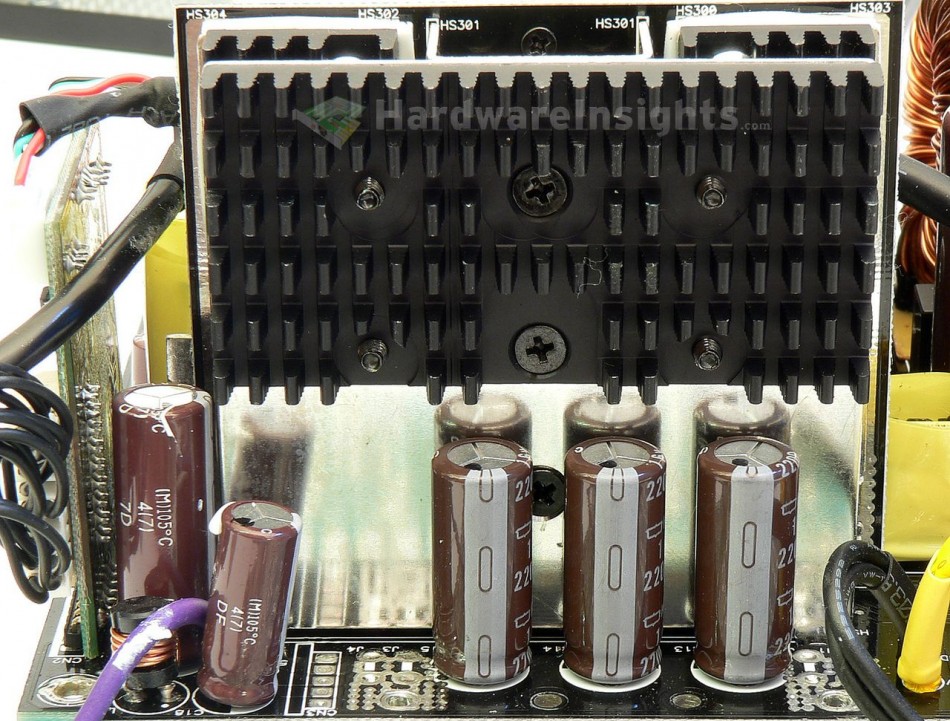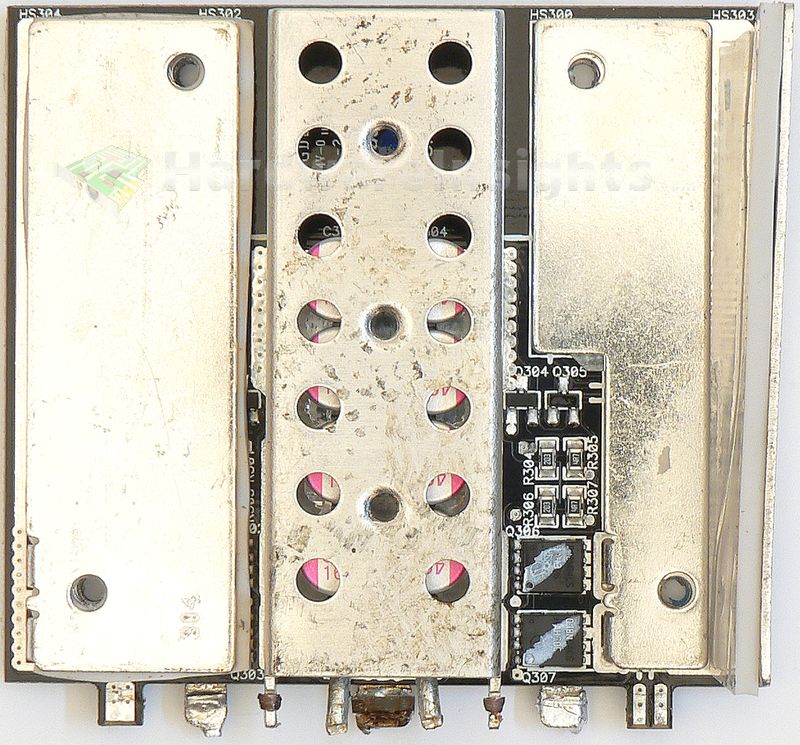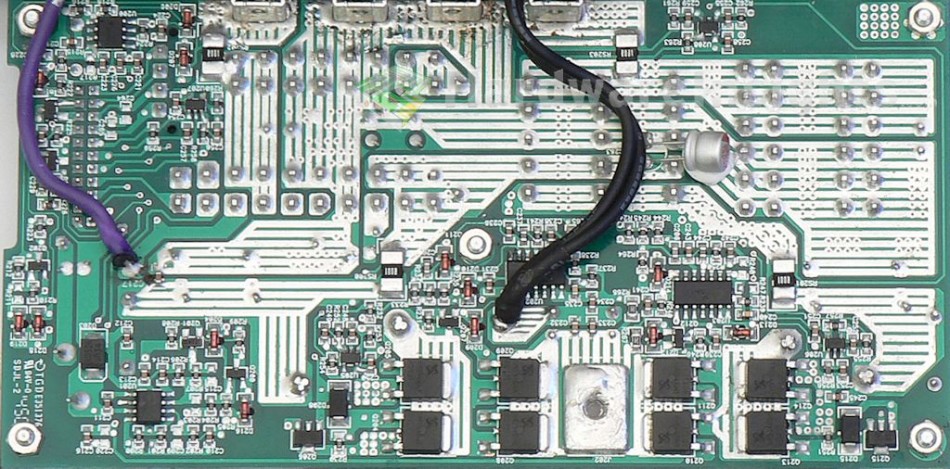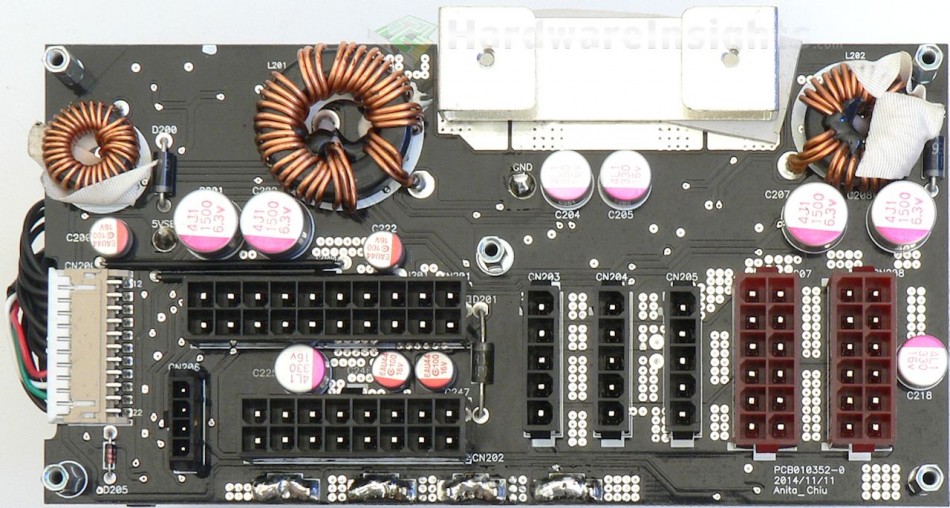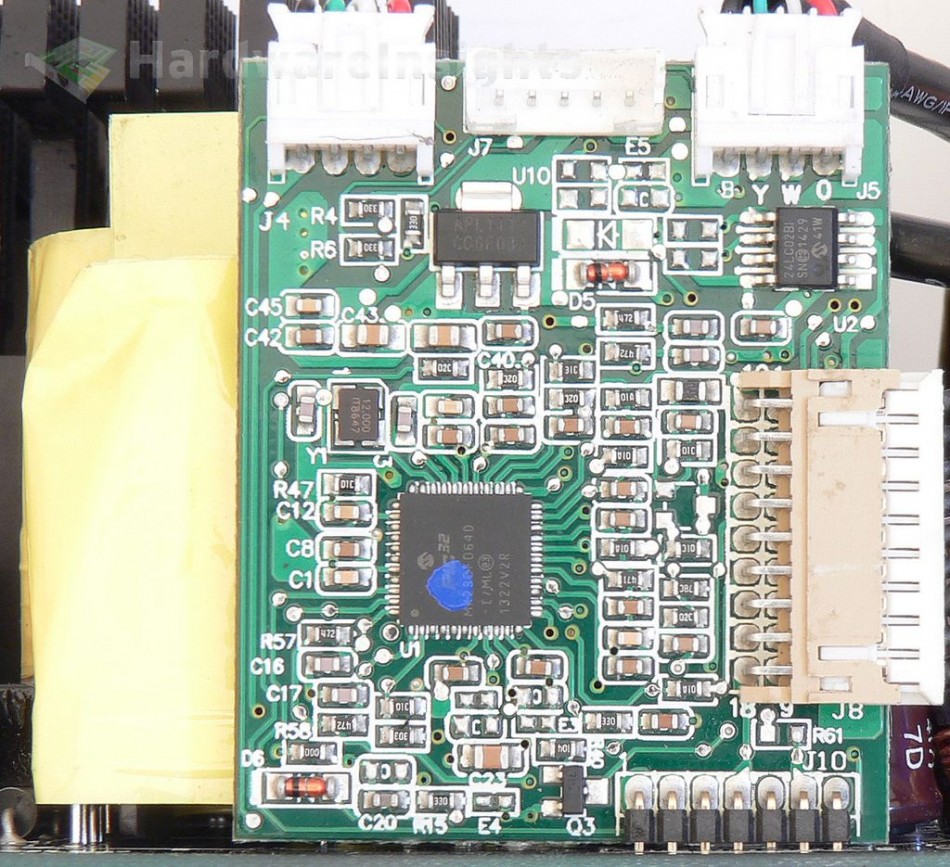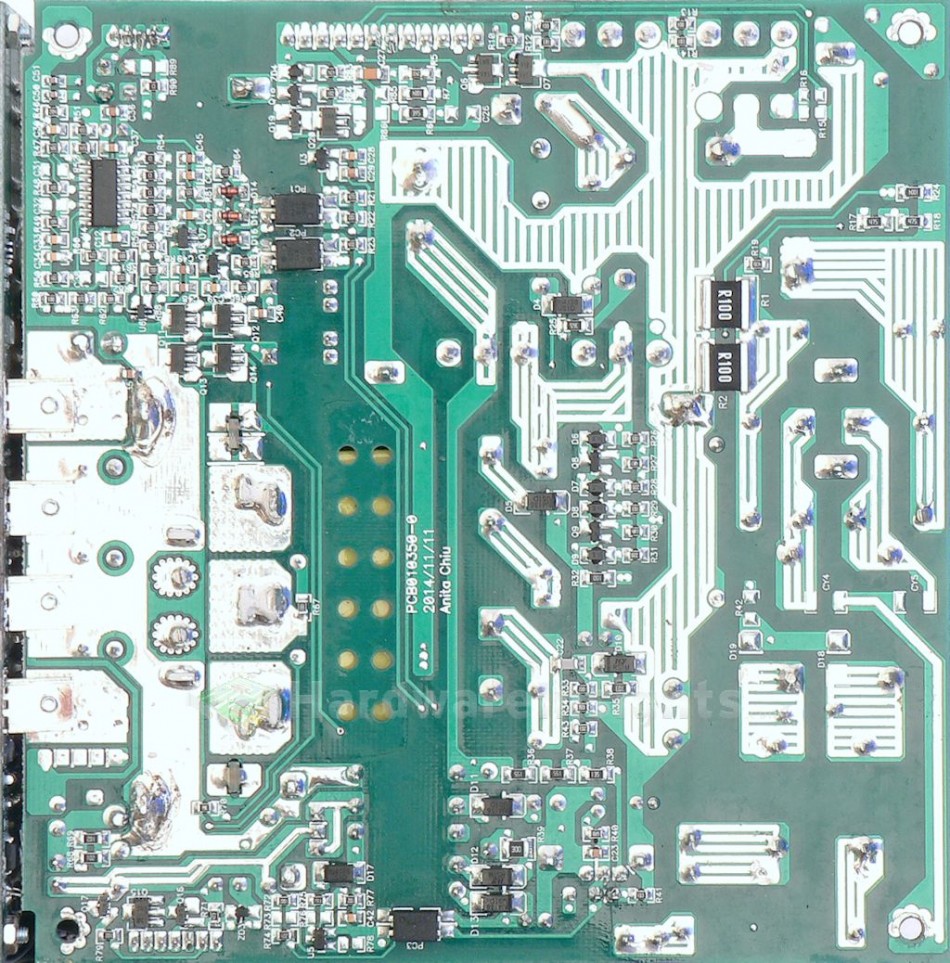Contents
- 1Introduction
- 1.1Packaging and accessories
- 2Connectors & cabling
- 2.1Casing & cooling
- 3Input filtering
- 4Primary side
- 4.1+5 V stand-by rail
- 5Secondary side
- 5.1Build quality
- 6Load testing
- 6.1Loading +5 V SB
- 6.2Combined loading
- 6.3Combined loading ripple
- 6.4Crossloading, overloading and the Sweater contest
- 6.5Crossloading, overloading ripple
- 7Conclusion and evaluation
- 7.1Thanks
Secondary side
The secondary part on the main board is quite small as there is only the +12V rectifying module in here and some filtration. The synchronous rectification here is handled by the big monstrosity in the picture which is probably that Copper-Bridge Array the box talks about. It was hell on Earth to remove that thing and you can see it meant some damage too, fortunately not too serious. When this goes wrong, Enermax is finished with such, I doubt anybody will be able to reasonably desolder the module and replace it. Basically there is a board with two pairs of Infineon BSC018N04LS G (100/400 A at 25 °C and 40 V, Rds(On) 2.5 mΩ at 50 A and 4.5 Vgs or 1.8 mΩ with 10 Vgs) transistors in modern PG-TDSON-8 package.
They are soldered on the board. On the back of the board, there are pretty thick strips of metal heavily soldered to this board and to the main board as well, they conduct all the AC power. The rectified DC flows through two very thick wires with ferrite toroids on them. Next to the transistors, laying on the board, is another strip of metal, most likely to help with cooling. Some silicone pads sit on this piece of metal and the transistors. Another piece of metal is on that and a third one heavily soldered to the backside too. This is the same for both pairs of transistors and it is all screwed together with black heatsinks – but that’s still not all! There is a group of eight Enesol Enecap 330/16 polymer capacitors sitting in the middle. Another metal plate with holes in it soldered above them and in the main board as it conducts the rectified ground. Still not all! Another big metal plate carrying yet another black heatsink is screwed to this metal-plate-with-holes and it is soldered to the main board too as it also conducts the rectified ground!
Then there are three Chemi-Con KZE 2200/16 capacitors on the main board for additional filtration. Not enough heavy soldering and metal plates yet? Here comes more! Four strips heavily soldered to the modular cabling board are screwed to the main board so all the power can flow to the connectors. There are two for +12 V and two for ground. Each has its own resistor shunt for the OCP of each +12V rail. Also two more 330/16 polymers. This is built like a tank! Another three points!
Both DC-DC modules are located on this board with all the components between the connectors (the same system as used with the Platimax family). To not disturb the +12 V power flow, they have their own conduction path – two pairs of 18AWG wires are here for ground (soldered in) and two for +12 V (screwed to a metal pad). The +12 V input is filtered by two more 330/16 polymers. Each DC-DC module uses Anpec APW7073A controllers (embedding UVP and OCP) and two pairs of Sinpower SM3116NAU (60/140 A at 30 V and 25 °C, Rds(on) 6.9 mΩ at 40 A and 125 °C) transistors in TO-252-3 package.
They are cooled with yet another metal plate transferring heat through a silicone pad to the Digifanless casing. Both the modules have a pair of 1500/6.3 polymers on their outputs with a few small 100/16 ones scattered among the connectors (two for +5 V and one for +3.3 V). The −12 V rail has a buck-boost converter fed from the +5 V rail using Anpec APW7174 controller and is filtered by two 100/16 polymers. A Silicon Touch Technology PS113 is used only for some under/overvoltage protection, turning the power supply on and providing power good signal.
Finally the digital part, its heart is a small daughterboard on the secondary side with Microchip Technology PIC32 microcontroler, the PIC32MX230F064D with 40MHz clock speed, 64 KB of program memory and 16 KB RAM. It monitors both primary and secondary side.
Build quality
As usual I will focus on the overall build quality and other things like electrical safety here as the quality of the components used was already discussed before. Thermistor present and has no sleeving but as long as it is relay-bypassed, I think it is OK. Varistor is sleeved with heatshrink. Filtration coils are NOT insulated with heatshrink, I would somewhat expect that of unit which cost similar fortune the Digifanless does. Otherwise there is enough room between components so no problem here. Primary and secondary side separation is good with some extra drilling under the main transformer for cooling. Almost all electrodes are very precisely cut. Several parts of the terrible rectification module have been (re)soldered manually. While I understand that, the work is not that nice, mine ended much better even after what the board went through in that process. I have also cleaned it better so two points down here for the soldering and cleaning and another point down for missing separator for that daughterboard on primary side.
There were almost no solder balls on the main board but six of them on the AC inlet as was already mentioned. More mess was around the metal plates which conduct power from main board and I would rather not talk about the stand-by rail wire which has virtually burned insulation around the soldering spot. Also, there is one badly soldered pin of one of those SATA/molex modular connectors. Conductive paths reinforcement, on the other hand, is very good with layers of extra solder and also metal plates or wire jumpers on paths conducting very high currents. I would guess that about a quarter to third of the weight of this unit is just solder. Being made by CWT, it could have been much worse for the complexity of the Digifanless, but on the other hand you are paying arm and leg for this 550watt unit. So even if it means giving the workers who repair bad soldering twice as much time for each unit and employing a few extra workers who will just brush the boards clean, they should have done that for this money instead of selling you this. So 13 points down altogether.
